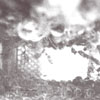 Consisting of two distinct conceptual pieces spread across a total of four tracks, La Casa creates sound based upon the disparate concepts of both nature and urban sprawl, utilizing field recordings in each case both in their untouched and heavily treated states. The complex result is simultaneously warm and inviting, yet cold and detached, exactly as the source material would lead one to expect.
Consisting of two distinct conceptual pieces spread across a total of four tracks, La Casa creates sound based upon the disparate concepts of both nature and urban sprawl, utilizing field recordings in each case both in their untouched and heavily treated states. The complex result is simultaneously warm and inviting, yet cold and detached, exactly as the source material would lead one to expect.
The opening piece, "Zone Sensible 2," is nearly a half hour of recordings based on beehives near Paris. The opening moments of the piece are unsurprising: the expected buzzes and hums of bees are present and grow in complexity, either as La Casa began to record closer to the hive, or via multi-track recording. Once the swarm arrives at the full level of intensity, it suddenly drops off via processing to near nothing, leaving only the most fragmented of sounds crackling away, the bees reappear again heavily under the influence of signal processing, covering everything in a shiny digital static sheen. The high frequency static coalesces with deep, undulating pulses before the untreated bees appear again, in concert with their digital counterparts. The processing brings out the pure tonal elements of the insects, creating warm tones light years away from the harsh textures of bee wings. The tones meld to create warm ambient electronic music, with insect interference coming in like static over radio transmissions. Eventually the bees take control, leaving the mix purely under the control of their wings before pulling away and allowing the subtle processed sounds to remain.
The remaining three tracks make up distinct segments of the "Dundee 2" piece, a collection of field recordings made around the city of Dundee, initially for use as a multitrack soundtrack to Ken Jacob’s "nervous magic lantern" film. The opening moments of the first piece are simply the clicking sounds of walking in an open parking garage. For me, this went from assumed to known the moment a booming voice cuts in, asking La Casa what he’s doing in the garage. The response, "I’m just recording space" is an honest one, but is still humorous to the befuddled guard, signaling a transition from the pure recordings to treated ones, leaving in bird songs over a low register hum and glitchy microsound delays shaped into a shrill rattle. Passages of echoing, open field sounds mix with the harmonic tones and digital stuttering, mixing both the natural world with the synthetic one.
The second segment is more forceful in its approach, with metallic rattling noises and heavy wind dominating the otherwise subtle sounds. Metal percussion like elements stick around, clashing against the otherwise complex subtlety, the heady mix ends with a surprising pastiche of church organ. The final segment goes even farther, with dense industrial clanging covering the bulk of the mix, with only the occasional voice from a field recording giving a human element to an otherwise mechanical track. The final two thirds retreat to a pensive ambience that contrasts the earlier intense noise.
While this disc joins two very different pieces, the fact that the two come from entirely different sound sources is irrelevant. La Casa utilizes the tonal qualities of both to conceptually highlight the inherent themes, but his adept hand at structure and composition gives them a coherent quality that both act as a microcosmic study of nature and society, but also a sonically compelling album that would stand high even without any sort of theme present.
samples:
Read More

